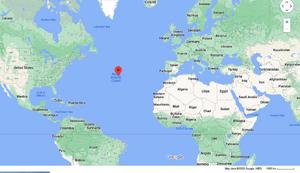Atlantic Ocean
| Author:Laxman Burdak, IFS (R) |

Atlantic Ocean is the second-largest of the world's five oceans, with an area of about 106,460,000 km2.[1] It covers approximately 20% of Earth's surface and about 29% of its water surface area. It is known to separate the "Old World" of Africa, Europe and Asia from the "New World" of the Americas in the European perception of the World.
Location
The Atlantic Ocean occupies an elongated, S-shaped basin extending longitudinally between Europe and Africa to the east, and the Americas to the west. As one component of the interconnected World Ocean, it is connected in the north to the Arctic Ocean, to the Pacific Ocean in the southwest, the Indian Ocean in the southeast, and the Southern Ocean in the south (other definitions describe the Atlantic as extending southward to Antarctica). The Atlantic Ocean is divided in two parts, by the Equatorial Counter Current, with the North(ern) Atlantic Ocean and the South(ern) Atlantic Ocean split at about 8°N.[2]
History
The oldest known mentions of an "Atlantic" sea come from Stesichorus around mid-sixth century BC (Sch. A. R. 1. 211):[3] Atlantikôi pelágei (Greek: Ἀτλαντικῷ πελάγει; English: 'the Atlantic sea'; etym. 'Sea of Atlas') and in The Histories of Herodotus around 450 BC (Hdt. 1.202.4): Atlantis thalassa (Greek: Ἀτλαντὶς θάλασσα; English: 'Sea of Atlas' or 'the Atlantic sea'[4]) where the name refers to "the sea beyond the pillars of Heracles" which is said to be part of the sea that surrounds all land.[5] In these uses, the name refers to Atlas, the Titan in Greek mythology, who supported the heavens and who later appeared as a frontispiece in Medieval maps and also lent his name to modern atlases.[6] On the other hand, to early Greek sailors and in Ancient Greek mythological literature such as the Iliad and the Odyssey, this all-encompassing ocean was instead known as Oceanus, the gigantic river that encircled the world; in contrast to the enclosed seas well known to the Greeks: the Mediterranean and the Black Sea.[7]In contrast, the term "Atlantic" originally referred specifically to the Atlas Mountains in Morocco and the sea off the Strait of Gibraltar and the North African coast.[8]The Greek word thalassa has been reused by scientists for the huge Panthalassa ocean that surrounded the supercontinent Pangaea hundreds of millions of years ago.
The term "Aethiopian Ocean", derived from Ancient Ethiopia, was applied to the Southern Atlantic as late as the mid-19th century.[9] During the Age of Discovery, the Atlantic was also known to English cartographers as the Great Western Ocean.[10]
The pond is a term often used by British and American speakers in reference to the Northern Atlantic Ocean, as a form of meiosis, or ironic understatement. It is used mostly when referring to events or circumstances "on this side of the pond" or "on the other side of the pond", rather than to discuss the ocean itself.[11] The term dates to 1640, first appearing in print in pamphlet released during the reign of Charles I, and reproduced in 1869 in Nehemiah Wallington's Historical Notices of Events Occurring Chiefly in The Reign of Charles I, where "great Pond" is used in reference to the Atlantic Ocean by Francis Windebank, Charles I's Secretary of State.[12][13]
अन्ध महासागर या अटलांटिक महासागर
अन्ध महासागर या अटलांटिक महासागर उस विशाल जलराशि का नाम है जो यूरोप तथा अफ्रीका महाद्वीपों को नई दुनिया के महाद्वीपों से पृथक करती है। क्षेत्रफल और विस्तार में दुनिया का दूसरे नंबर का महासागर है जिसने पृथ्वी का १/५ क्षेत्र घेर रखा है। इस महासागर का नाम ग्रीक संस्कृति से लिया गया है जिसमें इसे नक्शे का समुद्र भी बोला जाता है। इस महासागर का आकार लगभग अंग्रेजी अक्षर 8 के समान है। लंबाई की अपेक्षा इसकी चौड़ाई बहुत कम है। आर्कटिक सागर, जो बेरिंग जलडमरूमध्य से उत्तरी ध्रुव होता हुआ स्पिट्सबर्जेन और ग्रीनलैंड तक फैला है, मुख्यतः अंधमहासागर का ही अंग है। इस प्रकार उत्तर में बेरिंग जल-डमरूमध्य से लेकर दक्षिण में कोट्सलैंड तक इसकी लंबाई १२,८१० मील है। इसी प्रकार दक्षिण में दक्षिणी जार्जिया के दक्षिण स्थित वैडल सागर भी इसी महासागर का अंग है। इसका क्षेत्रफल इसके अंतर्गत समुद्रों सहित ४,१०,८१,०४० वर्ग मील है। अंतर्गत समुद्रों को छोड़कर इसका क्षेत्रफल ३,१८,१४,६४० वर्ग मील है। विशालतम महासागर न होते हुए भी इसके अधीन विश्व का सबसे बड़ा जलप्रवाह क्षेत्र है। उत्तरी अंधमहासागर के पृष्ठतल की लवणता अन्य समुद्रों की तुलना में पर्याप्त अधिक है। इसकी अधिकतम मात्रा ३.७ प्रतिशत है जो २०°- ३०° उत्तर अक्षांशों के बीच विद्यमान है। अन्य भागों में लवणता अपेक्षाकृत कम है।
External links
References
- ↑ https://www.britannica.com/place/Atlantic-Ocean
- ↑ "Atlantic Ocean Facts". U.S. Navy.
- ↑ Mangas, Julio; Plácido, Domingo; Elícegui, Elvira Gangutia; Rodríguez Somolinos, Helena (1998). La Península Ibérica en los autores griegos: de Homero a Platón – SLG / (Sch. A. R. 1. 211). Editorial Complutense. pp. 283–.
- ↑ "Ἀτλαντίς, DGE Diccionario Griego-Español". dge.cchs.csic.es.
- ↑ Herodotus. "Perseus Under Philologic: Hdt. 1.202.4". University of Chicago.
- ↑ Thomas, S. (8 June 2015). "How the oceans got their names". Oxford Dictionaries.
- ↑ Janni, P. (2015). "The Sea of the Greeks and Romans". In Bianchetti, S.; Cataudella, M.; Gehrke, H.-J. (eds.). Brill's Companion to Ancient Geography: The Inhabited World in Greek and Roman Tradition. Brill. pp. 21–42. doi:10.1163/9789004284715_003. ISBN 978-90-04-28471-5. p. 27
- ↑ Thomas, S. (8 June 2015). "How the oceans got their names". Oxford Dictionaries.
- ↑ p. 27
- ↑ Steele, Ian Kenneth (1986). The English Atlantic, 1675–1740: An Exploration of Communication and Community. Oxford University Press. p. 14. ISBN 978-0-19-503968-9.
- ↑ "pond". Oxford English and Spanish Dictionary, Synonyms, and Spanish to English Translator.
- ↑ Pond". Online Etymology Dictionary. Douglas Harper.
- ↑ Wellington, Nehemiah (1 January 1869). Historical Notices of Events Occurring Chiefly in the Reign of Charles I. London: Richard Bentley.

